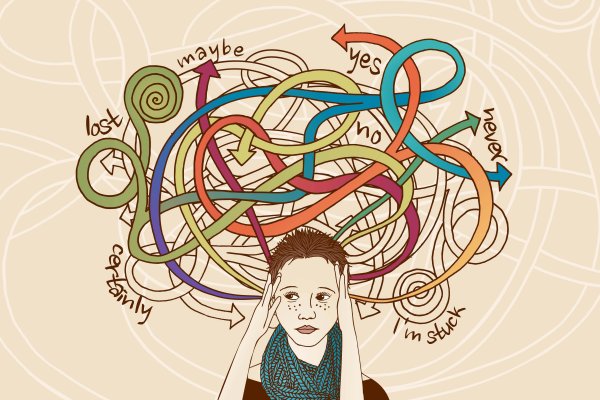The Only Way to Change Your Reality Is to Change Your Thoughts


Written and verified by the psychologist Fátima Servián Franco
There’s a reality out there, outside of us, but we don’t actually interact with it. The only reality we truly live in is a simulation created by our brain. It does this through our thoughts, which may or may not be close to the reality outside of us.
In theory, the less biased your thoughts are, the closer you’ll be to the truth. The problem comes when you’ve been taught generalizations, prejudices, and black-and-whites that distance you from what’s real. Thinking is like breathing; we do it without even realizing it. But you shouldn’t believe everything you think. In fact, some say that only about 20% of our thoughts actually become reality.
As human beings, we have thoughts that don’t line up with the reality of the time or situation. These are called distorted or irrational thoughts. They’re ideas that come to your head and keep you from seeing how things really are. They usually lead you to make mistakes, and that has a huge and very direct impact on your emotions.
Your interpretations of reality, not so much reality itself, are what make you an emotionally stable or unstable person. What you think about yourself and your experiences is what really underlies problems with anxiety or depression.
These conditions are extremely common in the developed world, but two people in the same situation might experience it and understand it differently. This is proof of how when it comes down to it, it’s your thoughts that create reality.

If you want to change yourself, change your thoughts
The foundation of many psychological theories is replacing irrational thoughts with other kinds that match up better to real facts. Learning how to change your thoughts from irrational to rational is the key. People who are able to modify their ways of thinking can get much more control over their emotions and make better decisions.
One of the most commonly used clinical techniques to change badly adjusted thinking is debate. This is where they show the patient how to modify their beliefs by questioning them based on rationality until the patient is able to come up with an alternative, better adjusted way of thinking. The ultimate goal is for the patient to be able to substitute or polish their thoughts on their own.
Even if the circumstances are difficult, like after losing a job or after a breakup, they won’t improve by overthinking. Instead, your margin for action has more to do with getting control over your thoughts than it does with getting control over reality.
How to change your thoughts to be healthy and rational
Occurrences aren’t what cause emotional and behavioral problems. Rather, they’re caused by the beliefs that underline our interpretation of the problems. One fundamental way to change your thoughts is to distinguish between rational thoughts and irrational ones.

Thinking in a rational way means thinking in relative terms. It means expressing yourself in terms of wishes and wants (I’d like, I’d prefer, I wish…). When someone has a healthy way of thinking, even when they don’t get what they want, the negative feelings that come up due to the situation won’t stop them from pursuing what they want.
On the other hand, having a rigid, dogmatic way of thinking means you express yourself in terms of obligation, need, or requirement (I have to, I should, I must).
When those things don’t happen then you’ll experience negative emotions (depression, guilt, anger, anxiety, fear) that interfere with your attempts to reach your goals. They also trigger behavioral changes like isolation, avoidant or escapist behavior, and substance abuse.
There’s a reality out there, outside of us, but we don’t actually interact with it. The only reality we truly live in is a simulation created by our brain. It does this through our thoughts, which may or may not be close to the reality outside of us.
In theory, the less biased your thoughts are, the closer you’ll be to the truth. The problem comes when you’ve been taught generalizations, prejudices, and black-and-whites that distance you from what’s real. Thinking is like breathing; we do it without even realizing it. But you shouldn’t believe everything you think. In fact, some say that only about 20% of our thoughts actually become reality.
As human beings, we have thoughts that don’t line up with the reality of the time or situation. These are called distorted or irrational thoughts. They’re ideas that come to your head and keep you from seeing how things really are. They usually lead you to make mistakes, and that has a huge and very direct impact on your emotions.
Your interpretations of reality, not so much reality itself, are what make you an emotionally stable or unstable person. What you think about yourself and your experiences is what really underlies problems with anxiety or depression.
These conditions are extremely common in the developed world, but two people in the same situation might experience it and understand it differently. This is proof of how when it comes down to it, it’s your thoughts that create reality.

If you want to change yourself, change your thoughts
The foundation of many psychological theories is replacing irrational thoughts with other kinds that match up better to real facts. Learning how to change your thoughts from irrational to rational is the key. People who are able to modify their ways of thinking can get much more control over their emotions and make better decisions.
One of the most commonly used clinical techniques to change badly adjusted thinking is debate. This is where they show the patient how to modify their beliefs by questioning them based on rationality until the patient is able to come up with an alternative, better adjusted way of thinking. The ultimate goal is for the patient to be able to substitute or polish their thoughts on their own.
Even if the circumstances are difficult, like after losing a job or after a breakup, they won’t improve by overthinking. Instead, your margin for action has more to do with getting control over your thoughts than it does with getting control over reality.
How to change your thoughts to be healthy and rational
Occurrences aren’t what cause emotional and behavioral problems. Rather, they’re caused by the beliefs that underline our interpretation of the problems. One fundamental way to change your thoughts is to distinguish between rational thoughts and irrational ones.

Thinking in a rational way means thinking in relative terms. It means expressing yourself in terms of wishes and wants (I’d like, I’d prefer, I wish…). When someone has a healthy way of thinking, even when they don’t get what they want, the negative feelings that come up due to the situation won’t stop them from pursuing what they want.
On the other hand, having a rigid, dogmatic way of thinking means you express yourself in terms of obligation, need, or requirement (I have to, I should, I must).
When those things don’t happen then you’ll experience negative emotions (depression, guilt, anger, anxiety, fear) that interfere with your attempts to reach your goals. They also trigger behavioral changes like isolation, avoidant or escapist behavior, and substance abuse.
All cited sources were thoroughly reviewed by our team to ensure their quality, reliability, currency, and validity. The bibliography of this article was considered reliable and of academic or scientific accuracy.
- Marín, N. L. (2006). La terapia racional emotiva de Albert Ellis. Norte de salud mental, 6(25), 126-129.
- Navas, J. J. (1981). Terapia racional emotiva. Revista latinoamericana de psicología, 13(1), 75-83.
- Municio, C. M. (2007). CÓMO COMBATIR LAS IDEAS IRRACIONALES: TERAPIA RACIONAL EMOTIVO CONDUCTUAL. In La psicología que nos ayuda a vivir: enciclopedia para superar las dificultades del día a día (pp. 575-588).
- Beck, J. (2015). Terapia cognitiva: Conceptos básicos y profundización (Vol. 141626). Editorial Gedisa.
- Aldás-Villacís, A., & Poveda-Ríos, M. (2021). Creencias irracionales y síndrome de burnout en el personal de salud del hospital José María Velasco Ibarra de la ciudad del tena en tiempo de covid-19. PSICOLOGÍA UNEMI, 5(9), 108-117.
This text is provided for informational purposes only and does not replace consultation with a professional. If in doubt, consult your specialist.







